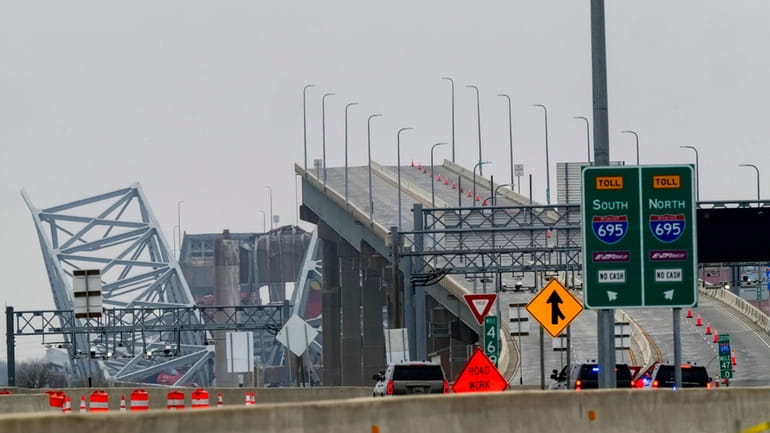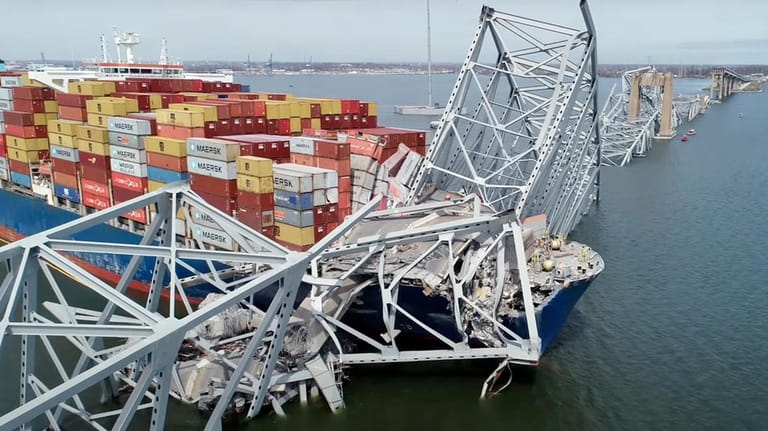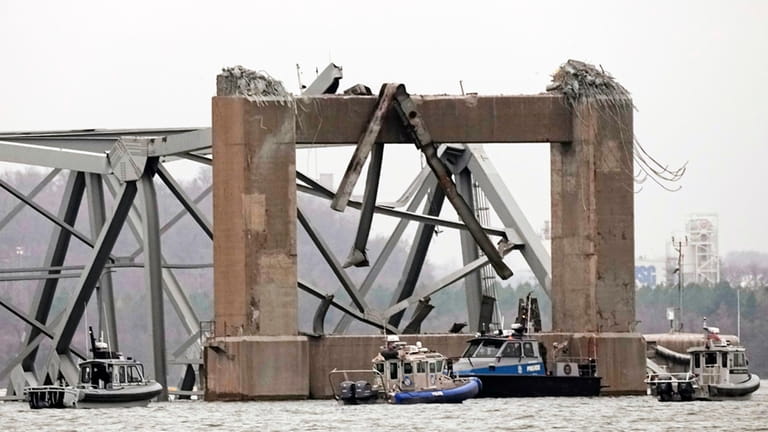Baltimore bridge collapse: Ships carrying cars and heavy equipment need to find a new harbor

Shown is the wreckage of Francis Scott Key Bridge as seen from Dundalk, Md., on Wednesday, March 27, 2024, Recovery efforts resumed Wednesday for the construction workers who are presumed dead after the cargo ship hit a pillar of the bridge, causing the structure to collapse. Credit: AP/Matt Rourke
Manufacturers and shippers are scrambling to figure out where they can load or unload cargo while the main operations of the Port of Baltimore remain shut down due to Tuesday's deadly collapse of the Francis Scott Key Bridge.
Supply chain experts say other ports up and down the East Coast are likely to absorb much of Baltimore's traffic, avoiding a crisis. But not without some longer shipping times and upheaval.
“Ultimately, most trade through Baltimore will find a new home port,” Moody's Analytics economist Harry Murphy Cruise wrote in a blog post.
U.S. Transportation Secretary Pete Buttigieg reiterated Wednesday that it was too soon to estimate how long it would take to clear the bridge structure from the 50-foot-deep (15 meters) Patapsco River channel, which leads to the port's main terminal.
The port's location makes it a key destination for freight. The Maryland Port Administration says the facility is an overnight drive from two-thirds of the U.S. population, and it's closer to the Midwest than any other East Coast port.
Here's a look at the goods that go through the Port of Baltimore and the potential impact of a prolonged port shutdown:
WHAT GOODS ARE SHIPPED TO AND FROM BALTIMORE?

In this image taken from video released by the National Transportation and Safety Board, the cargo ship Dali is stuck under part of the structure of the Francis Scott Key Bridge after the ship hit the bridge, Tuesday, March 26, 2024, in Baltimore. Credit: AP
Baltimore is the ninth-busiest port in the nation, but it leads U.S. ports in “roll on, roll off" cargo. That means goods with wheels, composed largely of automobiles but including construction and agricultural equipment.
The state of Maryland says the port moved 847,158 automobiles last year. About 70% of the wheeled cargo was imported.
The port also handles a large amount of wood, steel, aluminum, home appliances, furniture, sugar and liquefied natural gas. About 20% of U.S. coal exports pass through Baltimore, second only to the port in Norfolk, Virginia.
Shippers also use the port for containers, although other ports handle more of them. About 1 million containers went through Baltimore in the past year, about 2.8% of the container volume shipped through East Coast ports, according to S&P Global.

Police dive boats work around part of the structure of the Francis Scott Key Bridge after the ship hit the bridge Wednesday, March 27, 2024, in Baltimore, Md. Credit: AP/Steve Helber
In all, the port handled a record 11.7 million tons of cargo last year, the state said.
“For everybody who is buying cars, for everybody who is (buying) farm equipment, we’re the largest port in the country that does that," Maryland Gov. Wes Moore said. “So this is not just impacting Maryland.”
HOW MANY SHIPS STOP AT THE PORT?
More than 50 ocean shipping and cruise ship companies do business with the port, the state says, and their vessels visit the port about 1,800 times per year.
Last year, more than 444,000 passengers boarded cruise ships at the port from Royal Caribbean, Carnival, Norwegian and other cruise lines.
WHAT ARE BALTIMORE-BOUND SHIPS DOING NOW?
Many are waiting to get booked at other ports, pushing back their arrival dates for several weeks.
Windward Maritime said that from Monday to Tuesday, estimated time of arrival for Baltimore bound vessels doubled. The maritime risk management company predicted that ships scheduled to go to Baltimore would be delayed by at least 24 days.
The company also said its data shows a large increase in ships that are basically drifting in the North Atlantic, likely meaning they are waiting to see which port they will go to.
Some are anchored near Baltimore or nearby Annapolis, where a dozen vessels were waiting. Ships also are gathered near Norfolk.
WHERE ELSE WILL THE SHIPS GO?
Supply chain experts say it will take some time, and there will be disruption, but automakers and shipping companies will divert their cargo to ports up and down the East Coast.
Ports in Philadelphia, Wilmington, Delaware; Newark, New Jersey; Norfolk; Charleston, South Carolina; Jacksonville, Florida; and in Georgia also could see additional cargo.
The Georgia Ports Authority, which owns ports in Savannah and Brunswick, said it has capacity to take on more cargo. But it can't make up for Baltimore by itself.
Baltimore still can handle some autos. Part of its operations are east of where the bridge collapsed and are still operational, the port said. BMW and Volkswagen said they would still be able to use Baltimore.
WILL THE INCREASED SHIPPING TIMES RAISE PRICES OF GOODS?
Perhaps, although Moody's said finding substitute ports should minimize price adjustments for coal and vehicles. “That said, the reshuffle will squeeze other ports, potentially adding a smidge to shipping costs as delays spill to other goods,” analyst Murphy Cruise wrote.
HAVE OTHER PORTS HAD TO CLOSE AND WHAT HAPPENED THEN?
In September 2019, the South Korean freighter Golden Ray overturned shortly after leaving the Port of Brunswick in Georgia.
The crew was rescued, including four men trapped below its decks. But hauling away the shipwreck, including the cargo of 4,200 automobiles, turned out to be a slow and messy demolition effort that took over two years.
The port was closed for four days, reopening only after the U.S. Coast Guard determined it was safe for vessels to slowly sail on the shipping channel leading to the port.
The circumstances were much different from the bridge collapse in Baltimore, where sections of the structure lie across the river. Clearing a channel for ships likely will take far longer than four days.
During a briefing at the bridge collapse scene, U.S. Rep. David Trone said state and federal officials estimated the port's closure would cost the economy at least $15 million per day.
The Port of Baltimore directly employs over 15,000 workers and indirectly supports nearly 140,000 jobs via other port activities, many of whom will either be temporarily out of work or work limited hours, according to Trone.
_
